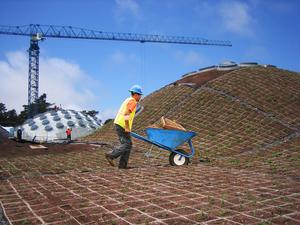SAN FRANCISCO, CA--(Marketwire - June 7, 2007) - Installation is now underway on the largest living roof in California, a 2.5-acre expanse of native plants atop the new California Academy of Sciences building in Golden Gate Park. Hailed as the most complicated living roof ever constructed by architects and contractors alike, the roof features seven dramatic hills blanketed with nine species of native plants. This innovative roof will make the new museum -- both literally and figuratively -- the greenest ever constructed. Designed by Pritzker Prize winner Renzo Piano, the new building is expected to be the first museum to achieve a LEED Platinum certification and will stand as an embodiment of the Academy's mission to explore, explain and protect the natural world.
During the initial search for a project architect in 2001, Renzo Piano's sketch for an undulating living roof that integrated the new Academy more sensitively into Golden Gate Park and made nature part of the building quickly won over Academy officials. To make Piano's vision a reality, Academy botanist Frank Almeda began working with a team of architects and living roof experts.
"Our goal was to choose native plants that were well adapted to the climate in Golden Gate Park and would provide much needed habitat for native birds, butterflies, and other beneficial insects," explains Almeda. "We also needed to select species that would look attractive throughout the year, since a visually appealing roof is a much more powerful educational tool."
Before the Academy's original home in Golden Gate Park was torn down in 2004, Almeda and his team spent two years testing over 30 species of native plants in steeply sloped planter boxes on the roof, where they were left to grow without fertilization or irrigation. After surviving this trial, nine hardy finalists were chosen: four perennial plants that Almeda affectionately refers to as "The Fab Four" and five annual wildflowers. These nine species will attract a wide variety of native wildlife, including the endangered Bay checkerspot and San Bruno elfin butterflies. Once installation is complete, the new Academy roof will offer the largest swath of native vegetation in San Francisco County.
The planted roof will also provide a number of other benefits. The iconic hills on the roof were designed not only for visual impact but also for energy conservation. The contoured roofline will roll over the Academy's domed planetarium, rainforest, and aquarium exhibits, echoing the topography of the building's setting and evoking the interdependence of biological systems. These hills, which feature slopes in excess of 60 degrees, will draw cool air into the open piazza at the center of the building, naturally ventilating the surrounding exhibit spaces. Strategically placed skylights in the roof will automatically open and close to allow heat to escape through the tops of the domes. They will also allow sunlight to reach the living rainforest and coral reef exhibits below, reducing the energy requirements for artificial lighting.
Padded with six inches of soil, the roof will provide excellent insulation, keeping interior temperatures about 10 degrees cooler than a standard roof. It will also decrease the urban heat island effect, staying about 40 degrees cooler than a standard roof. Moreover, it will absorb about 98% of all storm water, preventing up to two million gallons of runoff from carrying pollutants into the ecosystem each year.
Innovative Installation
The new Academy's living roof features much steeper slopes than any other living roof, so plant installation is challenging. To prevent the plants and soil from sliding down these slopes, Carmel-based Rana Creek Nursery developed an innovative and sustainable installation strategy. Using tree sap and coconut husk fiber, a waste product from coconut plants in the Philippines, they created porous, biodegradable trays in which to grow the Academy's plants. These trays are installed onto the roof like tiles and quickly become locked together as the plants' roots grow from one coconut husk tray into the next.
Once installation is complete, the roof will hold 50,000 coconut husk trays filled with 1.7 million plants. The trays will slowly biodegrade over the next several years, leaving a well-established carpet of colorful plants and wildflowers.
The New California Academy of Sciences
The new California Academy of Sciences will house Kimball Natural History Museum, Steinhart Aquarium and Morrison Planetarium, along with eight scientific research departments and 20 million scientific specimens. The new museum will open to the public in October 2008. This major initiative builds on the Academy's distinguished 154-year history and deepens its commitment to advancing scientific literacy, engaging the public, and documenting and conserving Earth's natural resources.
Contact Information: Contact: Stephanie Stone (415) 321-8119 sstone@calacademy.org
